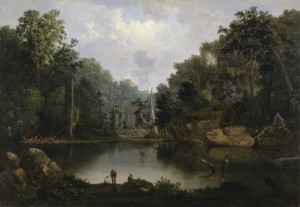 Brendan planted a Dawn Redwood for me in the northeast corner of the garden. I need it to fill a gaping hole in the tree-line left by unfinished construction work on the other side of the fence. It should grow quickly. There is a beautiful specimen on the west bank of Ellis Pond, probably planted in the late 1970s, which is now more than 30 feet tall. And it should last a while. Metasequoia is one of the oldest living tree species. Like the Ginkgo tree, its lineage stretches back to the time of the dinosaurs. The ancestor of today’s trees, “rediscovered” in China in the 1940s, was believed to be 500 years old.
Brendan planted a Dawn Redwood for me in the northeast corner of the garden. I need it to fill a gaping hole in the tree-line left by unfinished construction work on the other side of the fence. It should grow quickly. There is a beautiful specimen on the west bank of Ellis Pond, probably planted in the late 1970s, which is now more than 30 feet tall. And it should last a while. Metasequoia is one of the oldest living tree species. Like the Ginkgo tree, its lineage stretches back to the time of the dinosaurs. The ancestor of today’s trees, “rediscovered” in China in the 1940s, was believed to be 500 years old.
Metasequoia Paleontology ( via Wikipedia):
Metasequoia redwood fossils are known from many areas in the Northern Hemisphere; more than 20 fossil species have been named (some were even identified as the genus Sequoia), but are considered as just three species, M. foxii, M. milleri, and M. occidentalis.[2] Fossils are known from the Cenomanian onwards. During the Paleocene and Eocene, extensive forests of Metasequoia occurred as far north as Strathcona Fiord on Ellesmere Island and sites on Axel Heiberg Island (northern Canada) at around 80° N latitude.[3] Metasequoia was likely deciduous by this time. Given that the high latitudes in this period were warm and tropical, it is hypothesized that the deciduous trait evolved in response to the unusual light availability patterns, not to major seasonal variations in temperature.[4] During three months in the summer, the sun would shine continuously, while three months of the winter would be complete darkness. It is also hypothesized that the change from evergreen to deciduous trait occurred before colonizing the high latitudes and was the reason Metasequoia was dominant in the north.[5]
Large petrified trunks and stumps of the extinct Metasequoia occidentalis (sometimes identified as Sequoia occidentalis) also make up the major portion of Tertiary fossil plant material in the badlands of western North Dakota.
The trees are well known from late Cretaceous to Miocene strata, but no fossils are known after that. Before its discovery, the taxon was believed to have become extinct during the Miocene; when it was discovered extant, it was heralded as a “living fossil“.


![Sandhill cranes land on Platte River sandbar roosts west of Rowe Sanctuary’s Iain Nicolson Audubon Center southwest of Gibbon, Nebraska. [Photo by Lori Porter| Kearney Hub]](https://www.ghostturtles.com/wp-content/uploads/2015/03/sandhill_cranes_kearneyhub_032015-300x225.jpg)
![An endangered Whooping crane takes flight. Yhe large bird has a 7-foot wingspan. It is all white except for black wing tips and face markings. In this photo its long neck stretches forward; its wings sweep upward; and its black legs trail straight behind it. [Source: International Crane Foundation]](https://www.ghostturtles.com/wp-content/uploads/2023/03/Whooping-crane-eastern-ICF-080622-300x157.jpg)

![Mark Willis peruses a 1745 volume by Voltaire at a bouquiniste book stall on the banks of the Seine in Paris. He wears a brown leather jacket and checkered flat cap. He holds the open book in his hands. Rows of old books are seen on shelves behind him. [2005 photo by Ms. Modigliani]](https://www.ghostturtles.com/wp-content/uploads/2023/03/mw_bouquiniste_05-300x225.jpg)


